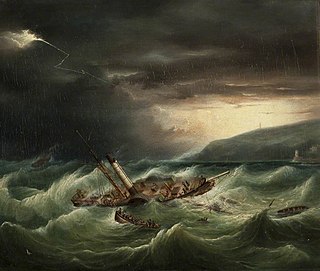Hilhouse was a shipbuilder in Bristol, England, who built merchantman and men-of-war during the 18th and 19th centuries. The company subsequently became Charles Hill & Sons in 1845.

The siege of Louisbourg was a pivotal operation of the Seven Years' War in 1758 that ended the French colonial era in Atlantic Canada and led to the subsequent British campaign to capture Quebec in 1759 and the remainder of French North America the following year.
Scatarie Island is an island in the Canadian province of Nova Scotia, located off the coast of Baleine, Cape Breton Island.
Alexander was a sailing ship built by Henry Baldwin and launched in Quebec in 1801. She was registered in London in 1802. She sailed for the British East India Company carrying wheat to New South Wales for the government, before returning to Britain via China. She spent a few years trading with the West Indies before she traveled to New South Wales again, this time transporting convicts. On her return to Britain new owners returned her to trading with the West Indies, but she is no longer listed after 1810 and her ultimate fate is unknown.
William Scott Shipbuilders was a short-lived shipbuilder in Bristol, England in the 19th century and an early producer of steamships. The yard was important in the development of Bristol Shipbuilding. Scott's assistant, William Patterson, went on to build SS Great Britain.
William Patterson Shipbuilders was a major shipbuilder in Bristol, England during the 19th century and an innovator in ship construction, producing both the SS Great Western and SS Great Britain, fine lined yachts and a small number of warships.
Boddingtons, or Boddington, was a merchantman that was launched in 1793 upon the Thames River for Boddingtons. She spent most of her career as a West Indiaman. She did make one voyage to Australia carrying passengers. Her crew abandoned her at sea in November 1840.
Albion was a sailing ship of two decks and three masts, built at Bristol, England, and launched in 1813. She made three voyages transporting convicts to Van Diemen's Land and New South Wales. She also traded with Jamaica, India, and Quebec. For two of the voyages to India she was an "extra" ship to the British East India Company (EIC).
Hadlow was a merchant sailing ship built in 1814 at Quebec, British North America. She made two voyages transporting convicts from England and Ireland to Australia. She plied between England, India, and Sierra Leone before being lost with all hands in 1823.
Elizabeth was a merchant ship built at Chepstow, Wales in 1809. She made three voyages transporting convicts from England and Ireland to Australia. Elizabeth is no longer listed after 1832 and may have been lost in 1831.
Grecian was a sailing ship which was wrecked in a storm off Port Adelaide, South Australia in October 1850.
Henry was a sailing ship built in 1819 at Quebec, Canada. She initially sailed between London and Quebec, but then she made two voyages transporting convicts from England to Australia. She was wrecked in the Torres Strait in 1825.
Numerous vessels have borne the name Fame:
Kingston was launched at Bristol in 1811. She traded between Bristol and Jamaica until her owners sold her in 1818. She then made two voyages for the British East India Company (EIC). Afterwards she continued trading with India, and then with Quebec. She was wrecked in 1833.
Wolfe's Cove was built by Baldwin & Co and launched in 1812 at Ile d'Orleans near Quebec. She sailed to England and from there first traded with Canada and then from 1816 with Mauritius, India, and Java. An American privateer captured her in 1813, but the Royal Navy recaptured her within weeks. She was damaged and hulked at Mauritius in 1819.
Earl of Buckinghamshire was built at Montreal in 1814. She sailed to Britain and made two voyages to India. She then started trading between Liverpool and North America. In 1821 she carried some 600 settlers from Greenock to Quebec. Her crew abandoned her in the North Atlantic in October 1822 and she was wrecked in November when she drifted ashore at Galway Bay, Ireland.
Skelton was launched in 1818 at Whitby. She made one notable voyage in 1820 to Australia, notable because her captain later published a detailed account with extensive economic, commercial, and other observational information about the Cape of Good Hope, Hobart Town, Port Jackson, and Rio de Janeiro. She later became a West Indiaman and was wrecked in 1828.

The first RMS St Patrick of the St. George Steam Packet Company was a wooden paddle steamer, launched by Mottershead & Hayes of Liverpool on 22 April 1822 for passenger service. The ship first served on the line's Dublin to Liverpool route, with a stopover in Bristol. The ship was sold in 1824 to Portuguese interests and renamed the ship Restaurador Lusitano, which operated on the Lisbon to Oporto route. Civil war broke out in 1828 and the vessel was chartered for service by the Absolutists in 1832. While sailing with troops and supplies, Restaurador Lusitano was severely damaged in a storm while attempting to aid another vessel in trouble. The damage was too much and Restaurador Lusitano sank on 11 September 1832.

